New Chesapeake Bay Improvement Plan Targets Agriculture
Pennsylvania developed a plan to improve the Chesapeake Bay’s water quality. The improvement plan includes the Chesapeake Bay model and highlights the need for the state to reduce its nitrogen, phosphorus and sediment loads in its watersheds.
“Pennsylvania is making incredible progress in meeting goals,” said Michael Langland, a hydrologist with the U.S. Geological Survey (USGS). “Unfortunately, Pennsylvania has the highest loads in the watershed.”
Nutrient runoff primarily comes from southeastern Pennsylvania, where most of the state’s intensive agriculture is located. Agriculture is the largest contributor to the watershed’s nutrient loads, but it has also shown the greatest improvement.
“We are showing a lot of progress as time goes on,” Langland said.
According to Dana Aunkst, deputy secretary, Office of Water Programs, Pennsylvania Department of Environmental Protection, the water quality measured by USGS shows more improvement than the computer data projection in the U.S. Department of Environmental Protection’s (DEP) Chesapeake Bay Model, which gives the state an unsatisfactory rating.
Aunkst said DEP is confident the state’s farmers have implemented best management practices without the cost-share support from the government that the computer model recognizes. This spring, Penn State led a multiagency effort to count voluntary best management practices for possible inclusion in the Chesapeake Bay Model. More than 1/3 of the 7,000 farmers responded.
Once the data are finalized, the aggregate results will be presented to the U.S. Environmental Protection Agency (EPA) for possible inclusion in the model. Farm-level data will remain confidential.
The data will document the installation of riparian buffers between farmland and streams. Cindy Dunn, secretary, Pennsylvania Department of Conservation and Natural Resources, said Pennsylvania used to lead the country in riparian buffers, but installations slowed during the 2000s. Her department seeks to plant trees and vegetation on 99,000 acres in the Susquehanna River watershed by 2025.
Officials say they are seeking federal funding and earmarking their budgets for the increased cleanup efforts. A pilot program also has been launched to work with the owners of smaller farms to experiment with building riparian buffers that incorporate commercial value.
In addition to riparian buffers, other farm practices are contributing to the bay cleanup, including cover crops, no-till cropping and stream bank fencing. Contributions off farms include lower nitrogen levels from air emissions and upgrades to sewage treatment plants.
The overall success of these efforts will be measured in 2025.
Source: Lancaster Farming


